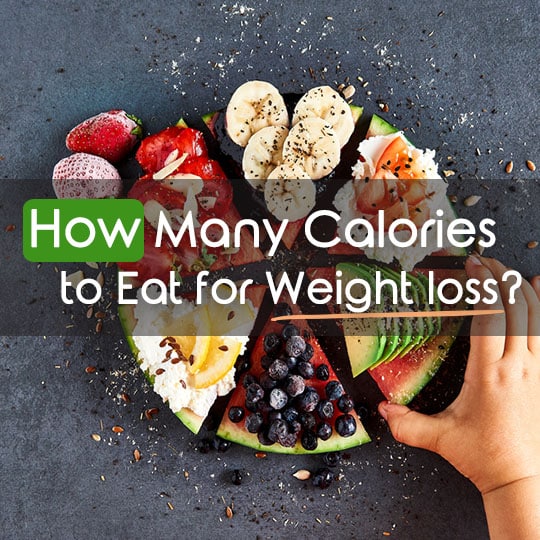When it comes to losing weight, there is one tried and true strategy that works every time. You will lose weight as long as you burn more calories than you’re consuming. The average man needs approximately 2500 calories a day to sustain their current weight while the average women requires 2000. If you eat less than this amount, you will likely lose weight. Specifically, research shows that men need to eat 2000 calories a day to lose a pound per week while women need 1500.

Keep in mind that these numbers may vary from person to person. You’ll need to take into account your age, current weight, height, metabolic health, and activity levels. This leaves many people wondering exactly how many calories they need to eat each day based on their unique needs to lose weight. This article can help you come up with that number.
What Are Calories?
Calories are a number unit that is used to measure the energy within food and beverages. The more energy dense a food is, the more calories it will likely have. Calories provide your body with energy that keeps you going all day long. You need calories to do simple tasks, such as breathing, as well as more complicated ones, such as running. If you want to maintain a stable weight, then the energy you put into your body must be the same as the energy you use daily based on your physical activity levels and normal bodily functions. The more active you are, the more energy or calories you require. But if you eat too many, you will gain weight.
You can check the calorie amount in the foods you eat by checking the nutrition label on the package. Calories are sometimes called kilocalories or kcals for short, so you might see a food label listed as having 200 kcals per serving. Carbohydrates and protein contain four calories per gram while fat contains nine calories per gram. Because of this, you can think of fat as being the most energy dense. Many people choose to cut fat from their diet when they are trying to lose weight but keep in mind that your body needs fat. In fact, it’s found in every cell membrane in your body. The best way to lose weight is by cutting refined sugar or processed foods, which are converted to fat in your body and stored as such. To help keep your calories down, you may want to use an online calorie counter to determine your needs best.
Best Online Calculator To Use
The good news is that technology makes it easy for you to determine how many calories you should be eating every day. Online calculators allow you to enter valuable information about your health, including your age, gender, height, weight and activity level, and determine what your magic number should be. Keep in mind that an online calculator can’t take into account individual medical conditions or needs, so you might want to check with a doctor if you need a more accurate number. For most of us, an online calculator is an excellent way to give you a ballpark number. You can download one to your phone for keeping track of calories on the go. Additionally, you might want to use an app or food calculator to measure the calories in your favorite foods. Then, you can add these numbers up and compare them to the number you get from your calorie counter for the day. Sometimes it helps to see the amounts you should be consuming when it comes to the food you eat. Here is our top pick for an online calorie counter:
Found it here
Tips For Reducing Your Calories
If you just use the above-mentioned online calculator for the first time, you might be shocked to see how many calories you should actually be eating compared to the ones you currently eat. Many people find that counting calories are the only way they can lose weight successfully, but doing so can be a pain. Luckily, there are many ways you can reduce the amount of food you eat without starving or even thinking twice about it. Keep in mind that not all calories are metabolized the same way in the body. For example, eating 300 calories worth of fruits and vegetables is much better for you than eating a candy bar with 300 calories. This is because fruits and vegetables contain key ingredients, such as fiber and antioxidants, that help you naturally lose weight. When it comes to losing weight, it’s always best to start with eating more whole, unrefined, plant-based foods and skipping the refined sugar entirely.
1. Eat more protein
Research shows that eating more protein can help you curb hunger, boost your metabolism, and fight calorie-dense sugary food cravings. The best part is that protein is easy to incorporate into your diet, making this strategy one of the best for reducing calories. You’ll feel sustained for more extended periods of time, which means you’ll be less likely to eat more. According to one study, protein curbs your appetite and increases your metabolic rate. Additionally, protein needs energy to become metabolized, so a high protein diet means that your body has to burn more calories just to break it down. In fact, you can burn up to 100 calories a day just by eating lots of protein.
Protein is also very filling, which means you’ll eat less overall. Research shows that people who ate 30 percent of their calories from protein reduce their total calorie count by 441 per day. At this rate, you would able to lose one pound per week just by eating more protein. Feeling full means that you will be less likely to crave bad foods. One study found that people who ate 25 percent of their calories as protein reduce their obsessive thoughts regarding food by 60 percent. They also cut their late night food cravings by 50 percent. Not only does protein help you lose weight, but it also prevents you from putting the weight back on if you stop dieting. Good sources of protein include lean meats, such as chicken and turkey breast, nuts, wild-caught fish, beans, ancient grains, eggs, legumes, and dairy products.
2. Avoid sugar and processed foods
Easier said than done, right? Actually, avoiding sugar isn’t that hard at all. You just have to know where it lurks and learn how to swap them out for healthy choices. Most people who quit sugar claim that they stop craving it after a few weeks of being off it. Everyone knows the basics. You should avoid sweets, candy, soda, sugary drinks and ice cream. But did you know sugar lurks in unsuspecting places such as condiments, bread, and even so-called healthy foods like energy drinks? As a general rule of thumb, it helps to cut out all liquids that aren’t water except maybe black coffee or tea when you’re trying to reduce calories. This is because liquids lack the fiber that helps you feel full. They are also absorbed directly into your bloodstream because they require less digestion, which spikes your insulin levels and makes you feel hungry when they contain sugar. Sweetened tea, chocolate milk, and store-bought juices are off limits.
Processed foods are also calorie dense, have limited nutrition, and make you put on weight. Typical examples include fast foods, snack foods such as microwaveable popcorn, potato chips, and crackers, as well as pizza, canned foods, and ready-made meals, such as frozen dinners, breakfast cereals or boxed macaroni and cheese. By definition, processed foods are foods that have been chemically altered in some way while they were being prepared. Many of them contain hydrogenated oils or refined sugar, which contribute to inflammation, digestive upset, and weight gain in the body. Basically, they make it easier for diseases to thrive in the body. Processed foods tend to be high in cheap ingredients with lots of additives. You can easily spot them by looking at their nutrition label. Look out for vegetable oils, excessive amounts of sodium, and trans fats. Food colorings and enriched, white flour are common ingredients in processed foods.
3. Focus on whole, unrefined plant-based foods
Some diet trends, such as the anti-inflammatory and Mediterranean diets, work by filling you up on whole, unrefined, mostly plant-based foods. Advocates of these diets claim that you don’t need to worry about calories as much when you’re eating whole food sources, and most of the time they’re right. Unrefined, plant-based foods contain healing nutrients that naturally help you lose weight, such as fiber, antioxidants, flavonoids, vitamins, minerals, and macronutrients. So while it’s true that you don’t need to be as concerned about counting calories from these food sources, you still might want to stick to recommended serving sizes when trying to lose weight.
For example, a one-quarter cup serving of sprouted brown rice contains 2 grams of fat, 4 grams of protein, and 2 grams of fiber, plus a ton of B vitamins for energy. Because of the sprouting process, it is easier to digest than regular rice, which makes it an excellent choice for people with sensitive stomachs. But it also contains 170 calories per serving, so you don’t want to double up on your helping if you’re trying to cut calories. Instead, fill the remainder of your plate up with green, leafy vegetables and a four to six ounce serving of a lean protein for the perfectly portioned dinner. Unrefined foods also lack many of the ingredients that tend to make you eat more calories than you realize, such as refined sugars, oils, and other flavorings.
When it comes to ingredients, fewer is better. Swap out sugary snacks for whole fruits, such as berries, apples, pineapple, cherries, oranges, and papaya. Add a serving or two of vegetables to each meal by throwing spinach in your morning smoothie, enjoying a salad at lunch, and preparing a stir-fry at night. Fill up on fiber-rich legumes and grains, such as chickpeas, green peas, quinoa, and oatmeal. Nuts and seeds are an excellent source of fiber and good fats to keep you full. Enjoy them raw as a snack or add to salads for a crunch. Cook your foods in healthy oils such as olive, avocado, coconut, and macadamia oils, and use spices to naturally enhance the flavor in place of sugar. This will help you stay on track.
4. Exercise
Exercising might not be on your list of favorite things to do, but it’s the best way to make sure you’re burning more calories than you’re taking in. And that’s the key to weight loss. Luckily, exercise doesn’t have to be torturous to be effective. You simply need to move more. Not a fan of the gym? No problem. Pack a pair of comfortable shoes at work and hit the stairs or take a walk on your lunch break. Grab a friend and meet them at an exercise class. This will help keep you accountable. You’ll also have more fun with a friend, which means you’ll be more likely to come back. Do you have a dog? Take Buddy for a 10-minute walk a few times a day. You’ll see even more results if you can incorporate some weight bearing resistance exercise into your routine. This is because when you build muscles, it helps you burn calories throughout the day. Invest in some free weights and get to squatting before you head out the door each morning.




